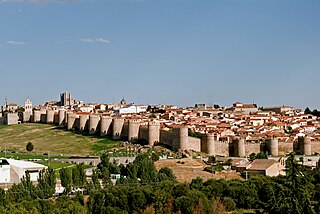
Romanesque architecture is an architectural style of medieval Europe characterized by semi-circular arches. There is no consensus for the beginning date of the Romanesque style, with proposals ranging from the 6th to the 11th century, this later date being the most commonly held. In the 12th century it developed into the Gothic style, marked by pointed arches. Examples of Romanesque architecture can be found across the continent, making it the first pan-European architectural style since Imperial Roman architecture. The Romanesque style in England is traditionally referred to as Norman architecture.

Segovia is a Spanish city located in the autonomous community of Castile and León. It is the capital and most populated municipality of the Province of Segovia.

Ávila is a city of Spain located in the autonomous community of Castile and León. It is the capital and most populated municipality of the Province of Ávila.

The Cathedral of St. Michael and St. Gudula is a medieval Roman Catholic church in central Brussels, Belgium. It is consecrated to St. Michael and St. Gudula, the patron saints of the City of Brussels, and is considered to be one of the finest examples of Brabantine Gothic architecture.

St. Bernard de Clairvaux Church is a medieval Spanish monastery cloister which was built in the town of Sacramenia in Segovia, Spain, in the 12th century but dismantled in the 20th century and shipped to New York City in the United States. It was eventually reassembled at 16711 West Dixie Highway, North Miami Beach, Florida, where it is now an Episcopal church and tourist attraction called Ancient Spanish Monastery.

The Aqueduct of Segovia is a Roman aqueduct in Segovia, Spain. It is one of the best-preserved elevated Roman aqueducts and the foremost symbol of Segovia, as evidenced by its presence on the city's coat of arms.

Aire-sur-la-Lys is a commune in the Pas-de-Calais department in northern France.

The Vall de Boí is a narrow, steep-sided valley and a small municipality in the province of Lleida, in the autonomous community of Catalonia, northern Spain. It lies in the northeastern corner of the comarca of Alta Ribagorça, on the edges of the Pyrenees. It is the largest municipality of the region, with its main town being Barruera.

The Cathedral of St. Mary of La Seu Vella is the former cathedral church of the Roman Catholic Diocese of Lleida, in Lleida, Catalonia, Spain, located on top of Lleida hill.
Fuentesoto is a municipality located in the province of Segovia, Castile and León, Spain. According to the 2009 census (INE), the municipality has a population of 178 inhabitants.

Santa María la Real de Nieva is a municipality located in the province of Segovia, Castile and León, Spain, about 30 km (18 mi) northwest of Segovia town. According to the 2010 census (INE), the municipality has a population of 1,193 inhabitants.
Santa María de Melque is a church in the province of Toledo in Spain. It has been described as the biggest fully vaulted early medieval church still standing in Western Europe. It is located in the municipality of San Martín de Montalbán, equidistant from the towns of La Puebla de Montalbán and Gálvez, between the brook Ripas and the river Torcón, a tributary of the river Tagus.

Segovia Cathedral is the Gothic-style Roman Catholic cathedral located in the main square of the city of Segovia, in the community of Castile-Leon, Spain. The church, dedicated to the Virgin Mary, was built in a Gothic style in the mid-16th century.

The architecture of Luxembourg probably extends back to the Treveri, a Celtic tribe who prospered in the 1st century BC. A few ruins remain from the Roman occupation but the most significant contributions over the centuries have been the country's castles and churches. Today there is a veritable architectural boom as Luxembourg's economic prosperity provides a basis for developments in the financial, EU and cultural sectors with a number of world-class buildings.

Teruel Cathedral or Catedral de Santa María de Mediavilla de Teruel is a Roman Catholic church in Teruel. Dedicated to St. Mary, it is a notable example of Mudéjar architecture. Together with other churches in the town and in the province of Zaragoza, it has been listed as a UNESCO World Heritage Site since 1986.

Romanesque architecture in Spain is the architectural style reflective of Romanesque architecture, with peculiar influences both from architectural styles outside the Iberian peninsula via Italy and France as well as traditional architectural patterns from within the peninsula. Romanesque architecture was developed in and propagated throughout Europe for more than two centuries, ranging approximately from the late tenth century until well into the thirteenth century.

Alarcón is a municipality in the province of Cuenca, in the autonomous community of Castilla-La Mancha, Spain.

Vigan Cathedral, canonically known as the Metropolitan Cathedral of the Conversion of St. Paul the Apostle is a Roman Catholic cathedral in Vigan, Ilocos Sur, Philippines. It serves as the seat of the Roman Catholic Archdiocese of Nueva Segovia. It is part of the UNESCO World Heritage Site declaration for the Historic Town of Vigan in 1999.

The Fuentidueña Apse is a Romanesque apse dated 1175–1200 that was built as part of the San Martín Church at Fuentidueña, province of Segovia, Castile and León, Spain. Little is known about the church's commission, design or early history. It is believed to have been built when the town was of strategic importance to the Christian kings of Castile in their defence against Moorish invaders; the church is situated on an imposing hill below a fortified castle.


















